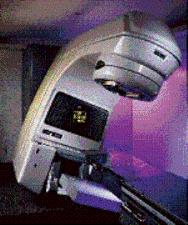
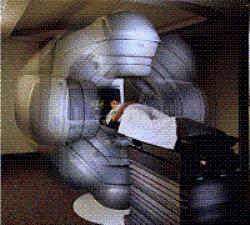
"Figure 1A & 1B: A.) A typical therapy machine. B.) Illustrates how the unit rotates around a patient giving radiation from any direction."
*X-Ray Vaults*
Introduction
Main
Summary
References and Further Reading
Introduction
In most medium to large hospitals there are radiation therapy or radiation oncology departments. In North America at the time of writing, the preferred method of creating radiation for therapy (not diagnostic or imaging but treating some disorder) is using a medical linear accelerator usually termed a “linac” or “clinic”. The term clinic is a brand name formed from “clinical linear accelerator”. The most popular is the American manufactured Varian clinic, which has about three quarters of the market share [Varian 2009]. The other two main competitors are Siemens [Siemens 2009], and Elekta [Elekta 2009]. In practical terms, the therapy medical x-ray machines are all pretty similar in the way that modern automobiles are all similar in shape and function. In some areas the treatment vaults are pretty common. In St Louis there are at least twenty.


"Figure 1A & 1B: A.) A typical therapy machine. B.) Illustrates how the unit rotates around a patient giving radiation from any direction."
Figure 1 shows a typical linac, this one a Varian Model 2100EX, which rotates around the patient, delivering radiation. Figure 1b shows a ghosted image to show how the unit can rotate right around the patient, who is almost always lying down on the job.
The radiation produced by these clinical treatment machines is quite penetrating, and in the higher end therapy machines, the x-rays are every bit as penetrating as the radiation from a nuclear weapon. In some clinical trials therapy machines have been used to simulate nuclear radiation.
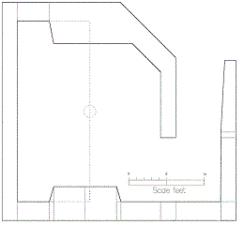
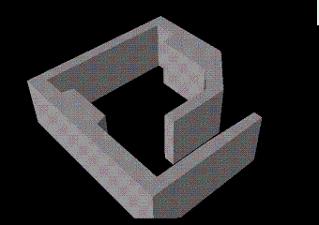
"Figure 2A & 2B: A.) A schematic drawing used to calculate the shielding needed. B.) A 3D rendering showing the thickness of concrete. This vault is one of three oncology facilities in a town of 100,000. Scale shows a ten foot length."
Main
With all of this high power radiation being generated, it is a sensible question to ask how the radiation workers and general public are protected from any stray radiation dose. The design of a therapy “vault” is like an inside out shelter, since the radiation is generated inside it. A typical value for a hard working department might be 1000Gy per week (100,000 RAD per week) generated by the machine in the treatment room. This dose is delivered in bits to all the patients who will be treated each day in the department.
The three standard answers used in designing radiation shielding are Time, Distance and Shielding. As far as time goes, well workers are (mostly) around all day, and nearby to any hospital are all the usual things like cafeterias, bookstores, army surplus and gun stores, and the usual things, so it is conventional to consider that the surroundings are continuously occupied. As for distance, well the hospital plans and locations tend to be set, so mostly a radiation department isn’t set up in the wilderness. That leaves shielding, usually something cheap and effective like concrete. How thick is that concrete? Usually three to six feet. Figure 2 shows a plan of a vault in a small southern California clinic, and a rendering of the wall areas. The roof of this vault is about three feet of concrete. Various companies specialize in the construction of these vaults, [RSS 2009] [Nelco 2009].
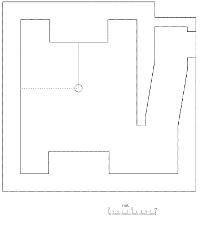
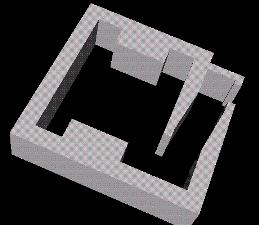
"Figure 3: Another vault in the Midwest. The walls here are a little thicker, the minimum being three and a half feet of concrete. This is one of seven vaults in a city of 100,000. Scale shows a ten foot length."
An alternative vault, from the Midwest is shown in figure 3. In both of the cases presented, the concrete was normal density of 147 lbcf.
Usually the concrete has a density of 147 lbs per cubic foot (2.35 tonnes per cubic meter, although some clinics, when they are paused for space can’t afford to waste six or eight feet and create much denser mixes by adding iron ores. [Seattle 2001]. Occasionally, steel will be used because a department doesn’t have the room to spare for concrete, because the basement are of the hospital can’t be expanded, so steel or lead can be used. What thickness? Well I was in one that had 13 inches of interlocking lead bricks inside it. Another used 12 inches of steel on the roof because above it was a pediatric ward.
Protection Factors
The protective shielding of concrete is tabulated in terms of Tenth Value Layers (TVL) in various official standards [NCRP151]. For therapy x-ray energies a value of 43cm (about 17 inches) of standard concrete us reasonable. Three feet corresponds to a protection factor of 36/17 = 2.1 TVL’s or about 131. Since three feet of earth is usually considered a protection factor of about a thousand, you can see that the medical high energy is a little more penetrating than atomic fission radiation. In fact the lowest x-ray energy in medicine today (termed “4MV”) is listed as having a TVL of 30cm or 12 inches, which would give three feet of earth a protection factor of one thousand. (Three TVL = 10x10x10 = one thousand). Against “low” energy Cobalt 60, the standard conservative medical TVL is listed as 21 cm (8 ¼ inches) of concrete, which is about 4 and a third TVL’s, which is a protection factor of around 22,000. If the vault happens to be underground, use an exotic form of treatment like neutrons or protons or have adjacent treatment rooms, the wall thickness might go up to six or seven feet all around, so the protection factor will be off the chart.[Cyclotron 2009]
Summary
In conclusion, radiation oncology treatment vaults are pretty well built and can serve as improvised shelters. Even if fallout lands on the roof, there will typically be three feet on concrete overhead (Sometimes much more). At least one part of your local hospital is built to survive the zombie nightmare.
References and Further Reading
Online:
[Cyclotron 2009] A (rare) cyclotron vault. The scale is in meters. A special concrete mix was used and the walls are about seven feet thick, and its underground.
http://en.wikipedia.org/wiki/File:UWMC-Schematic.png
[Eleckta 2009] Elekta 2009
http://www.elekta.com/healthcare_us_elekta_oncology.php
[Nelco 2009] Nelco
http://www.nelco-usa.com/linear_accelerator_sliding_door_systems.php
[RSS 2009] Radiation Shielding company, pictures of the equipment
http://www.radiationshieldingsystems.com/therapy.html
[Seattle 2001] Seattle cancer care alliances concrete 350 pounds per cubic foot.
http://www.djc.com/news/const/11122221.html
[Siemens 2009] Siemens oncology
http://www.medical.siemens.com/webapp/wcs/stores/servlet/CategoryDisplay~q_catalogId~e_-1~a_categoryId~e_12757~a_catTree~e_100010,1008643,12757~a_langId~e_-1~a_storeId~e_10001.htm
[Varian 2009] Varian Medical systems, Palo Alto CA
http://www.varian.com/us/oncology/radiation_oncology/
Offline:
[NCRP151] Structural shielding design and evaluation for megavoltage x-ray and gamma –ray radiotherapy facilities. National Council on Radiation Protection and Measurements 2005
Radiological71
www.alpharubicon.com
All materials at this site not otherwise credited are Copyright © 1996 - 2009 Trip Williams. All rights reserved. May be reproduced for personal use only. Use of any material contained herein is subject to stated terms or written permission.